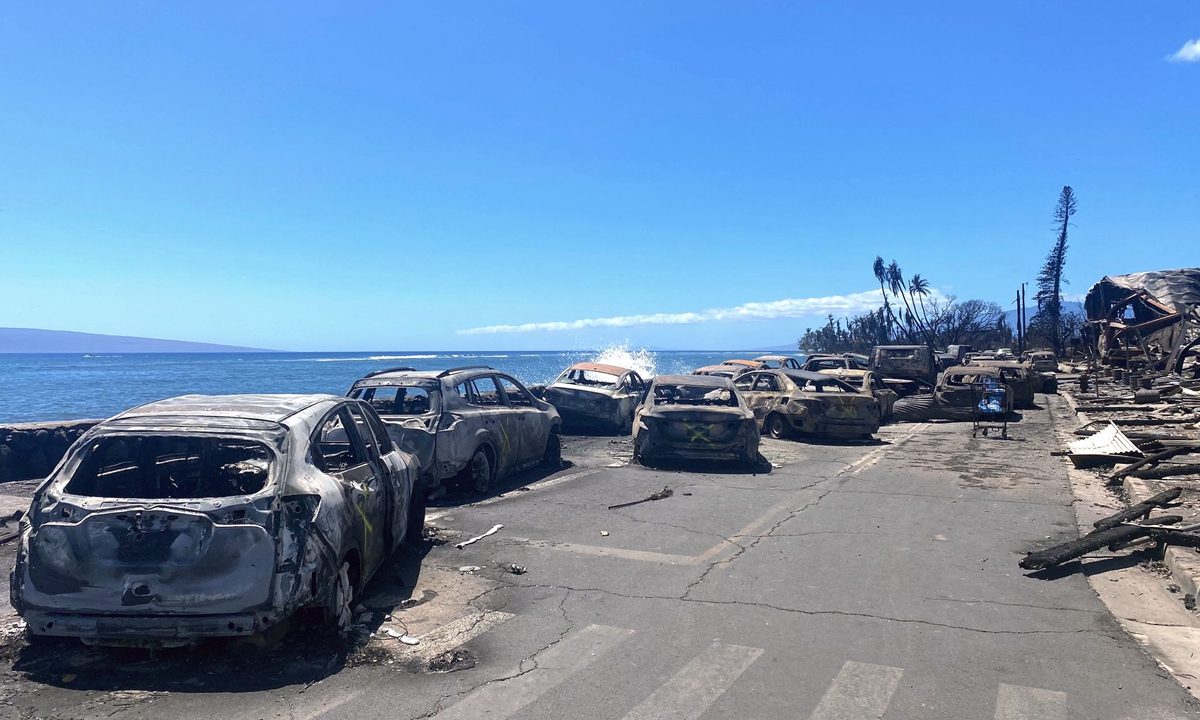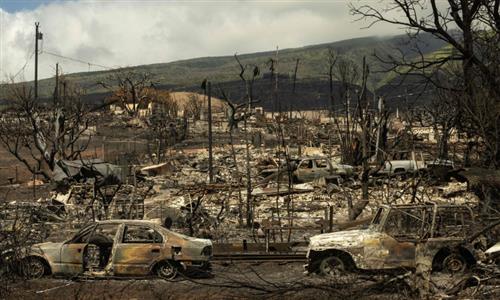IN-DEPTH / IN-DEPTH
Maui wildfire tragedy once again exposes US’ incompetence in natural disaster, emergency rescues
Unbearable pain

Burned cars and destroyed buildings are pictured in the aftermath of a wildfire in Lahaina, western Maui, Hawaii on August 11, 2023. Photo: VCG
News of the devastating wildfire on the Hawaiian island of Maui reminds Chinese oceanologist Wang Yamin of the pristine island he visited nine years ago. Wang still remembered the days when he was amazed by the dazzling blue ocean, the lush green of the trees, and the pretty little houses hidden among vegetation.
During an academic trip to Hawaii in August 2014, Wang lived in the renowned, historical town of Lahaina, and hiked up the mountain in the early mornings to watch the glorious sunrise.
However, now Lahaina was tragically and almost entirely leveled by the sudden fire. The fire, which started on August 8, has reportedly killed at least 114 people and left over 1,000 unaccounted for to date, and is considered one of the deadliest wildfires in modern American history.
"What a pity for Maui and its people," Wang sighed. The fire not only resulted in numerous casualties, but also destroyed much of the island's vegetation and caused air and marine pollution, he told the Global Times.
Days on, the international community has witnessed just how much this wildfire has turned part of Maui, once a land of idyllic beauty, into a scene of horror, carnage, and ruin straight out of a Hollywood horror movie. Worse still, the island's broken early warning system, slow and poorly coordinated rescue efforts, and the US' disappointing disaster response and mobilization mechanisms have, to some extent, transformed the natural tragedy into a man-made one, observers pointed out.
Strong storms, high temperatures, offshore rescue, and other objective factors do make the [rescue] process and efforts in Maui more difficult, emergency management specialist Wan Yanhua, a professor at the Huazhong University of Science and Technology, told the Global Times. "However, the human factors that led to the ineffective rescue operations cannot be ignored."
Belated rescues
US President Joe Biden eventually landed on Maui on Monday after his vacation at Delaware beach. It had been 13 days since the island was hard hit by the deadly wildfire.
"My heart, my prayers, and my focus are on the victims of the Maui wildfires and their families," said Biden on Sunday before his Maui visit, according to the White House website.
The House earlier claimed that Biden-Harris administration had "mobilized a robust whole-of-government response effort" to support immediate and long-term rescue and recovery efforts in Maui. "Dozens of Federal departments and agencies" have been working with state and local partners on the ground to assess emergent needs and providing resources and personnel to support response efforts, the White House website stated on August 15.
But such rhetoric has done little to assuage people's anger at the slow response of the US government during the ongoing tragedy. Not until August 10 did Biden approve the disaster declaration for Hawaii and unlock federal rescue resources to be used in Maui, nearly two days after the fire broke out, Hawaii News Now reported on August 11, let alone the criticism garnered from the president telling reporters during his beach getaway that he had "no comment" to the rising death toll in Maui.
Delays in the arrival of outside help undoubtedly intensified people's suffering. "It was a kind of fear and panic that I have never experienced before in my life," hotel manager Kawena Kahula told CBS News on August 15.
Kahula recalled that she didn't see any first responders when she self-evacuated a short drive from Lahaina. While Lahaina sat in ruins, "no assistance came for two days," CBS quoted Kahula as saying.
"…thousands of grief-stricken survivors questioned the competence and capability of the government," The Washington Post said on Sunday. "We were just in shock," said Maui local Kai Lenny. "And it was just like, day after day, 'Where are they?'"
Dozens of calls were made by the Global Times to local restaurants, hotels, and shops during local business hours at the weekend, only three answered the phone.
"We are still open," a restaurant staffer told the Global Times. "I have some friends who are in a bad situation. There is not much [outside] help," she said before hanging up the phone.
It's hard to know when Maui, including its pillar tourism industry, will fully recover from the devastation of the wildfires.
In an email reply to the Global Times on Monday local time, T. Ilihia Gionson, a public affairs officer at the Hawaii Tourism Authority, said a request was made that visitors avoid going to West Maui - the resort areas of Lahaina, Kaanapali, and Kapalua.
Overburdened firefighting capacity
"In the early hours of this disaster, we worked to get visitors off the island of Maui to allow attention and resources to be focused on the people of Maui," Gionson told the Global Times. "We ask that visitors be mindful that Hawaii is a small community and that many people may have strong connections to those who were affected by the tragedy."
Early damage assessments related to the fire showed that, as of August 11, 2,719 structures were exposed, 2,207 structures were damaged or destroyed, and 2,170 acres were burned, according to the US Pacific Disaster Center and the Federal Emergency Management Agency.
Hawaii Governor Josh Green estimated that Maui is facing nearly $6 billion worth of damage, reported CNN on August 19.
With dry weather, complex terrain, and gale-force winds, Maui is a high-risk area for wildfires. The island's relatively weak fire-fighting capability that doesn't match its fire risk has therefore become a focus of public concern in light of the recent deadly disaster.
The island had only about 65 firefighters on call and 13 fire engines designed for urban use, rather than off-road or wildland use, reported the Guardian on August 11.
Bobby Lee, the president of the Hawaii Firefighters Association told the media, "You're basically dealing with trying to fight a blowtorch," when describing the huge mismatch between the firefighting capability of the island and the scale of the wildfire on Maui.
With power outages in the local area and no access to television or radio, residents were reported to have received no text alerts or television or radio notifications, according to media reports.
To make things worse, local residents said that fire hydrants ran out of water, which hindered firefighters' ability to contain the fire. FEMA officials have also confirmed that there was an issue that affected the hydrants' water supply, CBS News reported on August 17.
Alan Dickar, a Front Street business owner, said he watched business after business in the historic district goes up in flames.
While buildings on both sides of the most important business street on Maui were engulfed, there were no fire trucks at present the time, Hawaii News Now quoted Dickar as saying. "I think the fire department was overwhelmed."
On social media platforms including TikTok, Instagram, and Twitter, many local residents on Maui and opinion leaders in the US criticized the US governments' lackluster rescue efforts.
Tragedy repeats itself
This fire incident has exposed several issues in the way the US handles wildfires: Weak public awareness in reporting emergencies, failures in local warning systems, insufficient rescue forces, and weak mobilization capabilities, Wan concluded.
"It is truly baffling that the administrator at the Maui Emergency Management Agency decided not to sound warning sirens when a devastating wildfire was ravaging the town of Lahaina. This also reflects the incomplete research, analysis, and consideration of disasters by the emergency management department," Wan told the Global Times.
Sadly, this is not the first time that the US has suffered huge tragedy resulting in mass casualties due to ill-equipped rescue mechanisms and poor rescue capabilities in natural disasters such as fires.
In 2018, nearly 10,000 buildings in Paradise Town, California, were destroyed by wildfires. The town was home to 27,000 residents before it was engulfed in flames. About 80 people were confirmed dead, and nearly a thousand including several centenarians were also reported missing, according to a BBC report on November 20 that year.
The then US president Donald Trump declared a state of emergency in California on November 10. He blamed California's officials for wildfires. "Billions of dollars are given each year, with so many lives lost, all because of gross mismanagement of the forests," he criticized on social platform.
In recent years, the US has not placed as much emphasis on emergency rescue as it had before. By contrast, China has attached great importance to the development of emergency rescue capabilities, according to Wan.
"We have established the Ministry of Emergency Management, which coordinates comprehensive departments and mechanisms at all levels from grassroots to top levels," explained Wan.
Moreover, China normally employs firefighters from local areas who are more familiar with local conditions in emergencies. "In large-scale disaster relief scenes, the presence of the Chinese People's Liberation Army (PLA) and the People's Armed Police can always be seen, which is extremely rare in the US, as the US military rarely participates in disaster relief work, and more are often seen carrying firearms to prevent unrest among the people during disasters," Wan added.
China has been making persistent, top-down efforts in strengthening its comprehensive emergency response system to better tackle a variety of disasters and accidents.
In the 2013-2021 period, the number of people dead or missing in natural disasters on average each year decreased by 87.2 percent compared with the 2000-2012 period.
China has also accelerated the transformation and upgrading of fire and rescue teams, creating over 3,500 professional teams specializing in water, mountain and earthquake rescue, and other emergency response fields.
The slow response and insufficient mobilization capacity displayed by the US government as seen during many natural disasters and emergencies have also made some people on the island of Taiwan have mixed feelings about the country's dependability.
On social media, some Taiwan residents called the Biden administration and US army "cold-blooded." "If the close-at-hand Maui Island was unable to [receive support in time], how can the Tsai administration believe that the faraway US army would come and 'rescue' Taiwan?" one mocked.
Natural disasters and the situation in the Taiwan Straits are two different things that are incomparable, commented a Chinese mainland research fellow on Taiwan studies. "Nonetheless, the fire has made some Taiwan secessionists realize that the US is not as 'reliable' as they expected," he told the Global Times.

